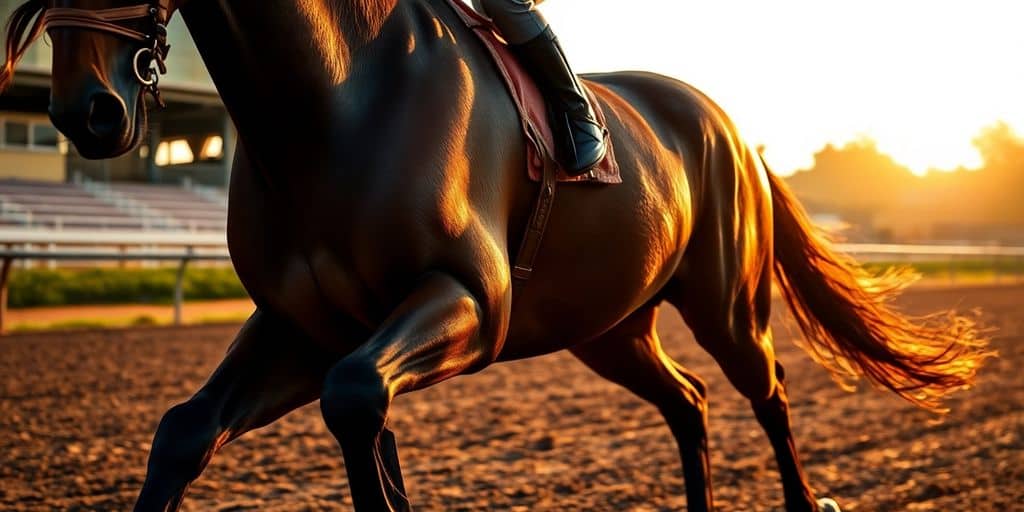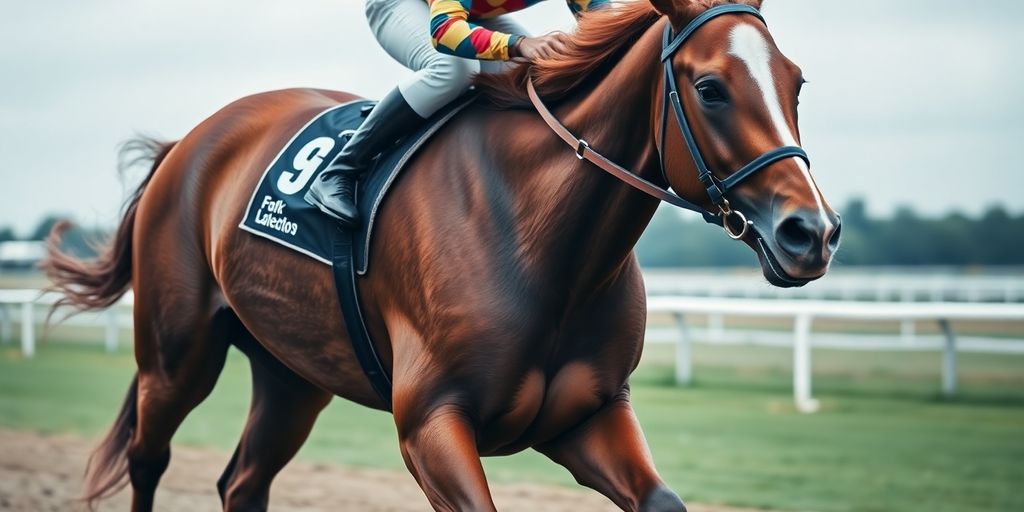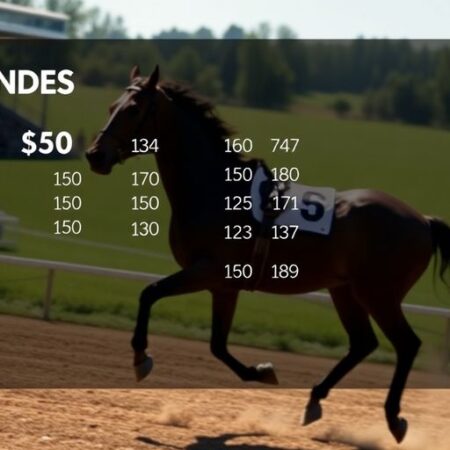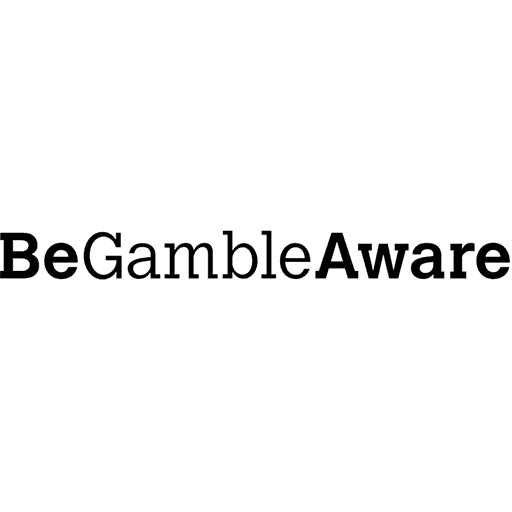Getting into online betting horses can seem a bit much at first. There’s a lot to consider, from picking the right site to figuring out what all those numbers mean. But don’t worry, with a little guidance, you can get the hang of it. This article will break down how to approach online horse betting, giving you some good ideas and practical advice to help you out.
Key Takeaways
- Always check out a horse’s past races and how they’ve been doing lately. This info helps you make smarter choices.
- Think about the jockey riding the horse. A good jockey can make a big difference, even with a so-so horse.
- See how the track is on race day. Is it muddy? Dry? This can really change how horses perform.
- Don’t just bet on your gut feeling. Do some homework and look for odds that seem better than they should be.
- Try to avoid making simple mistakes, like betting too much on one race or not doing your research.
Mastering Online Betting Horses Fundamentals

Understanding Basic Concepts
Getting into online horse betting means you need to know the basics. It’s not just about picking a horse with a cool name. You’ve got to get a handle on things like different bet types, what the odds mean, and how races actually work. For example, a ‘win’ bet is simple: your horse has to finish first. But then there are ‘place’ bets (first or second) and ‘show’ bets (first, second, or third), which are safer but pay less. Then you get into exotic bets like exactas, trifectas, and superfectas, where you pick the top finishers in exact order. These can pay out big, but they’re much harder to hit. Knowing these different bet types is key to building any kind of strategy. It’s like learning the rules of a new game before you start playing for keeps. You wouldn’t jump into poker without knowing what a flush is, right? Same idea here. You also need to understand how the track surface can affect a horse, whether it’s dirt, turf, or synthetic, and how weather conditions might change things up. It’s all part of the puzzle.
Choosing the Right Online Provider
Picking where you place your bets is just as important as picking your horses. Not all online betting sites are created equal. You want a provider that’s reliable, easy to use, and offers good customer support. Think about things like payment methods – do they accept what you use? Are their withdrawal processes quick and painless? Some sites might have better odds on certain races, or offer different types of promotions. It’s worth doing a little digging to find a good fit. You also want to make sure they’re licensed and regulated, so your money is safe. There are many reliable sports betting sites out there, but it’s up to you to find the one that fits your needs. Don’t just go with the first one you see. Look for reviews, check out their interface, and maybe even try their customer service with a quick question before you commit. A good provider makes the whole experience smoother.
Analyzing Odds Calculations
Odds are more than just numbers; they tell you a story about a horse’s chances and what your potential payout could be. Understanding how odds are calculated is pretty important. Bookmakers set these odds based on a bunch of factors: a horse’s past performance, the jockey, the trainer, track conditions, and even how much money is being bet on that particular horse. When you see odds like 5:1, it means for every dollar you bet, you could win five dollars. So, a horse with 2:1 odds is considered more likely to win than a horse with 10:1 odds. But here’s the thing: odds can change right up until the race starts, especially as more money comes in. This is called the ‘pari-mutuel’ system, where all the money bet on a race goes into a pool, and then payouts are made from that pool after the track takes its cut. It’s not like fixed-odds betting where you lock in your price. Knowing how these odds move and what they represent can help you spot value. Sometimes, a horse might have higher odds than you think it should, which could be a good betting opportunity. You can also find sports betting bonuses that might give you a bit of an edge when you’re starting out.
It’s easy to get caught up in the excitement of horse racing, but taking the time to understand the underlying mechanics of betting, from the different types of wagers to how odds are formed, will serve you well in the long run. This foundational knowledge is what separates casual bettors from those who approach it with a more strategic mindset. Don’t rush the learning process; it’s an investment in your future betting success.
Strategic Approaches for Online Betting Horses
Implementing Value Betting
Value betting is all about finding those moments when the odds offered by a bookmaker are actually higher than the true probability of an event happening. It’s like finding a sale on something you know is worth more. This strategy requires a sharp eye for identifying discrepancies between your own assessment of a horse’s chances and the odds presented. You’re essentially looking for situations where the market has underestimated a horse. It takes a bit of practice to get good at it, but when you do, it can really pay off. Think of it this way: if you believe a horse has a 30% chance of winning, but the bookmaker’s odds imply only a 20% chance, that’s where your value lies. It’s not about picking winners every time, but about making bets where the odds are in your favor over the long run. This approach is a cornerstone for anyone serious about making money in horse racing. For more general strategies, check out winning in sports betting.
Utilizing the Dutch Betting Strategy
The Dutch Betting Strategy is a clever way to guarantee a profit, or at least minimize losses, by betting on multiple horses in a single race. The idea is to spread your bets across several horses in such a way that no matter which of your chosen horses wins, you end up with the same profit. It’s a bit like hedging your bets. This strategy is particularly useful in races where you have a strong feeling about a few contenders but aren’t sure which one will cross the finish line first. It involves a bit of math to calculate the exact stakes for each horse, but there are plenty of online calculators that can help with that. The goal is to ensure your total payout covers your total outlay and leaves you with a profit. It’s a more conservative approach than just picking one horse, but it can be very effective for managing risk.
Here’s a simplified example of how it works:
- Identify multiple horses with a good chance of winning.
- Calculate the stake for each horse to ensure an equal profit if any of them win.
- Place your bets.
This strategy is not about hitting a huge jackpot on one horse, but about consistent, smaller gains by covering multiple outcomes. It’s a disciplined approach that can help smooth out the ups and downs of betting.
Backing Longshots Effectively
Backing longshots can be a high-risk, high-reward strategy. These are horses with high odds, meaning they are not expected to win. However, if you can identify an undervalued longshot, the payout can be substantial. The key here is "effectively." You can’t just bet on every longshot and expect to make money. It requires a deep understanding of horse form, track conditions, and jockey performance to spot those rare instances where a longshot has a better chance than the odds suggest. It’s about finding the needle in the haystack. Many experienced bettors look for longshots that have shown flashes of brilliance in previous races but perhaps had bad luck or were in unsuitable conditions. When those conditions change, and the odds haven’t adjusted, that’s your opportunity. For those interested in online betting, understanding online gambling for horse racing can provide more context on how these bets are placed. It’s a strategy that demands patience and a willingness to accept frequent losses for the occasional big win. It’s not for the faint of heart, but the rewards can be significant when you get it right. When considering where to place these bets, exploring best sports betting sites can be helpful.
Key Factors in Online Betting Horses Analysis
Evaluating Past Performance and Form Guides
When you’re looking at horse racing, one of the first things you gotta do is dig into a horse’s past. It’s like checking someone’s resume before hiring them, you know? You want to see what they’ve done before, how they’ve performed in similar situations. This means looking at their previous races, their finishing positions, and even how they looked during those races. A horse might have won, but if it struggled to do it, that tells you something different than a horse that won easily. Understanding a horse’s history is a big part of making smart bets. You can find all this info in what they call "form guides." These guides are packed with data, like where the horse ran, what the track was like, and who the jockey was. It’s a lot to take in at first, but once you get the hang of it, it becomes second nature. You’re basically trying to build a picture of the horse’s capabilities and how consistent it is.
Assessing Jockey Skill and Competition
Okay, so you’ve looked at the horse, but what about the person riding it? The jockey is a huge piece of the puzzle. A great jockey can sometimes make an average horse look good, and a less experienced one can mess up a good horse’s chances. You need to consider their track record, how many wins they have, and if they’ve ridden this particular horse before. Do they have a good relationship? Do they know how to handle different race situations? It’s not just about the jockey, though. You also have to look at the competition. Who else is in the race? Are there any other really strong horses or jockeys that could give your pick a run for its money? It’s like a chess match out there, and every piece matters. You’re trying to figure out who has the best chance to win, and that means looking at all the players involved. For more on this, check out master horse racing betting.
Considering Track Conditions Impact
This is a big one, and it’s often overlooked by new bettors. The track conditions can totally change how a race plays out. Is it a dry, fast track? Or has it been raining, making it muddy and slow? Some horses love a wet track, they just seem to glide through it, while others absolutely hate it and will perform terribly. You need to know what kind of track your horse prefers. This information is usually available before the race, and it’s something you should always check. It’s not just about wet or dry, either. Sometimes tracks can be "good," "soft," "heavy," or "firm." Each of these conditions favors different types of horses. Ignoring track conditions is like trying to drive a sports car on a dirt road – it’s just not going to go well. When you’re looking for fastest withdrawal sportsbooks, remember that understanding these factors can help you make better decisions before you even place a bet. And if you’re betting on the go, make sure you’re using one of the best mobile betting apps that provides this kind of detailed information easily.
Practical Tips for Successful Online Betting Horses
Conducting Thorough Research
When you’re looking to place a bet on a horse, you can’t just pick a name you like. That’s a surefire way to lose your money. You really need to dig deep and gather as much information as you can about the horses, the jockeys, and even the track itself. Think of it like being a detective. You’re looking for clues that will lead you to the best possible outcome. This means checking out past performances, looking at how a horse has done on similar tracks, and seeing if the jockey has a good history with that particular horse. It’s all about making smart, informed choices, not just guessing.
- Look at recent race results for the horse.
- Check the horse’s performance on different track conditions (wet, dry, turf, dirt).
- Research the jockey’s recent wins and their history with the horse.
- Consider the trainer’s success rate and recent form.
Analyzing Overpriced Odds
This is where you can really make some money. Sometimes, the odds offered by the bookmakers don’t quite match up with what you think the horse’s real chances are. This is what we call "overpriced odds." It means the bookmaker has underestimated a horse, and if you’ve done your research, you can spot these opportunities. It’s like finding a hidden gem. You’re looking for situations where the odds are higher than they should be, given the horse’s actual probability of winning. If you can consistently find these, you’re in a good spot.
It’s not about betting on every race; it’s about waiting for the right moment, when the odds are in your favor. Patience is a virtue in this game, and recognizing when a horse is undervalued can significantly boost your returns over time. Don’t just chase favorites; look for the value.
Avoiding Common Betting Mistakes
Everyone makes mistakes, especially when they’re starting out. But in online horse betting, mistakes can cost you real money. One of the biggest ones is chasing losses. You know, when you lose a bet and then immediately place another one, hoping to win back what you lost. That almost never works out. Another common mistake is betting with your heart instead of your head. You might have a favorite horse, but if the data says it’s not going to win, you need to listen to the data. And don’t forget about managing your money. You need a budget, and you need to stick to it. For example, when preparing for the Kentucky Derby 2025, it’s easy to get caught up in the excitement, but discipline is key.
Here’s a quick list of things to avoid:
- Chasing Losses: Never try to win back lost money by placing more bets.
- Emotional Betting: Don’t let personal favorites or gut feelings override your research.
- Poor Bankroll Management: Always set a budget and stick to it, no matter what.
- Ignoring Track Conditions: The weather and track surface can drastically affect a horse’s performance.
- Betting Blindly: Always do your research; never bet without understanding why you’re placing a wager.
Optimizing Your Online Betting Horses Experience
Leveraging Multiple Betting Systems
To really get the most out of your online horse betting, you shouldn’t just stick to one way of doing things. Think about it like having a toolbox; you wouldn’t use just a hammer for every job, right? The same goes for betting. Different races, different horses, and different odds call for different approaches. Using a mix of betting systems can seriously boost your chances of coming out ahead. It’s about being flexible and smart with your wagers.
- Try combining value betting with a bit of dutching on certain races.
- Look into systems that focus on specific track conditions or jockey forms.
- Consider how different systems perform with various bet types, like win, place, or exacta.
It’s easy to fall into a routine, but in betting, routines can sometimes lead to missed opportunities. By exploring and applying various betting systems, you’re not just diversifying your approach; you’re also learning more about the sport and how different factors play into outcomes. This knowledge is a powerful tool for any bettor looking to improve.
Identifying Profitable Opportunities
Finding those sweet spots where you can make some money is what it’s all about. It’s not just about picking winners; it’s about picking winners at good prices. This means you need to be sharp at spotting when the odds offered are better than the horse’s actual chance of winning. It takes a bit of digging, but the payoff can be worth it. For example, sometimes a horse might have a slightly off last race, making its odds longer than they should be, but all its previous form suggests it’s a strong contender. That’s a profitable opportunity right there. You can also look for free betting opportunities to test out your theories without risking your own money.
Maximizing Monthly Yields
Getting your monthly yield up is the goal for any serious bettor. It’s not just about winning big once in a while; it’s about consistent, steady gains over time. This means keeping a close eye on your betting records, understanding what strategies are working, and ditching the ones that aren’t. It’s a bit like managing a small business; you need to know your inputs and outputs. For instance, if you’re betting on soccer matches, you’d track your wins and losses for different leagues or bet types. Here’s a simple way to think about it:
| Strategy Type | Average Monthly Win Rate | Average Monthly Return on Investment (ROI) |
|---|---|---|
| Value Betting | 15% | 12% |
| Dutching | 20% | 8% |
| Longshot Backing | 5% | 15% |
To really maximize your returns, you might want to check out some BetOnline tips for improving your overall betting strategy. It’s all about making smart choices, consistently.
Advanced Techniques for Online Betting Horses
Unlocking Tote Board Secrets
Alright, so the tote board, or totalizator board, is more than just a display of odds. It’s a real-time snapshot of how the public is betting, and if you know how to read it, you can find some serious advantages. See, the odds on the tote board aren’t fixed like with a bookmaker; they shift based on how much money is being wagered on each horse. This means if a lot of money suddenly comes in on a horse, its odds will drop. Smart bettors look for horses whose odds are dropping faster than expected, or those that are getting a lot of late money. This can signal that insiders or sharp bettors know something you don’t. It’s like watching the stock market, but for horses. You’re looking for those sudden spikes in activity that tell you something’s up. It’s not always a guarantee, but it’s a strong hint.
Recognizing Betting Stable Moves
This one’s a bit more subtle, but it can be super effective. "Stable moves" refer to when a particular racing stable, known for its betting prowess, starts putting significant money on one of its own horses. These stables often have inside information about a horse’s fitness, training, or readiness that isn’t public knowledge. It’s not about illegal activity; it’s just about having a better read on their own animals. How do you spot it? Well, it often shows up as a sudden, large wager on a horse that might not look like a strong contender on paper. You’ll see the odds on that horse suddenly shorten, sometimes dramatically, just before post time. It’s like they’re saying, "We know something you don’t." Keeping an eye on these late shifts, especially from well-known stables, can give you a real edge. It’s a bit of a gut feeling combined with watching the numbers.
Identifying Odds Advantage Horses
Finding an odds advantage horse is basically finding value. It’s when you believe a horse has a better chance of winning than the odds offered by the betting market suggest. This isn’t about blindly picking favorites; it’s about doing your homework and finding discrepancies. Here’s how you can try to do it:
- Compare Odds Across Platforms: Different online betting sites might have slightly different odds for the same horse. Always check a few to find the best price. It’s like shopping around for anything else, you want the best deal.
- Develop Your Own Ratings: Don’t just rely on the public’s opinion. Create your own system for rating horses based on their form, track conditions, jockey, and other factors. If your rating says a horse should be 5-1, but the market has it at 10-1, you’ve found an advantage.
- Look for Overlooked Factors: Sometimes, the public misses something important. Maybe a horse is coming off a bad race but had a legitimate excuse (like a poor start or being boxed in). Or maybe a jockey change is more significant than people realize. These hidden gems can offer great value. For more horse betting tips, consider these overlooked factors.
It’s not about always picking winners, but about consistently finding situations where the odds are in your favor. Over time, these small advantages add up. It’s a marathon, not a sprint, and patience is key. You’re looking for those moments where the market has misjudged a horse’s true chances. This is where the real money is made, not just by picking the fastest horse, but by picking the horse that’s undervalued. For those new to the game, understanding horse betting basics is a good starting point.
Conclusion
So, that’s the scoop on online horse betting. It’s not just about picking a horse you like; there’s a bit more to it. You’ve got to think about things like how the track is, what the horse has done before, and even the jockey. And yeah, finding a good betting site matters too, especially one that makes it easy to pay. If you keep these things in mind, you’ll be in a much better spot to enjoy the races and maybe even win some cash. It’s all about being smart and doing a little homework before you place your bets.
Frequently Asked Questions
What is a low-risk horse racing strategy?
This strategy often involves placing bets on the race favorites or using the Dutching system. Dutching means betting on multiple horses in a single race so that the total amount won is the same, no matter which horse wins. This method lowers the risk and makes sure that if at least one of your chosen horses wins, you’ll get some money back.
What things affect horse racing?
Many things affect horse racing, like the horse’s past races, how good the jockey is, and the weather conditions on the track. Understanding these can help you make smarter bets.
What’s the best way to make money in horse racing?
The most profitable horse racing strategy is often seen as value betting. This is when you find a difference between what you think a horse’s chance of winning is and the odds the bookmaker gives. By finding these differences, you can make more money.
How do I pick a winning horse?
To pick a winning horse, you should look at its past performance, how well the jockey rides, and what the track conditions are like. Doing your homework on these things can help you make good choices.
Can I bet on multiple horses in one race?
Yes, you can bet on more than one horse in a race using strategies like Dutch betting. This lets you spread your bets across several horses, so your possible winnings stay the same no matter which of your chosen horses wins.
What are some tips for getting better at online horse betting?
To get better at online horse betting, you should always do your research, look for odds that seem too high (overpriced), and try not to make common mistakes. Also, learning how to read the tote board and understanding how betting stables place their money can give you an edge.












